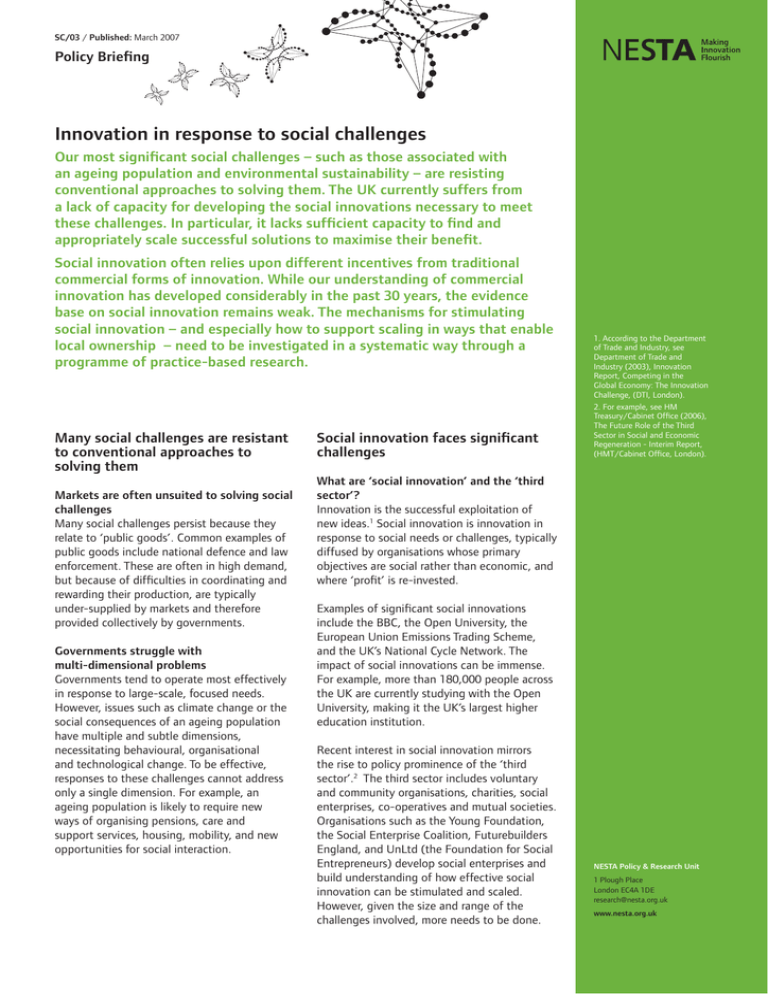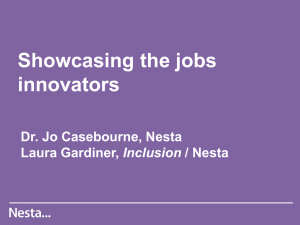Nesta Policy Brief Social Challenges.indd
advertisement

SC/03 / Published: March 2007 Policy Briefing Innovation in response to social challenges Our most significant social challenges – such as those associated with an ageing population and environmental sustainability – are resisting conventional approaches to solving them. The UK currently suffers from a lack of capacity for developing the social innovations necessary to meet these challenges. In particular, it lacks sufficient capacity to find and appropriately scale successful solutions to maximise their benefit. Social innovation often relies upon different incentives from traditional commercial forms of innovation. While our understanding of commercial innovation has developed considerably in the past 30 years, the evidence base on social innovation remains weak. The mechanisms for stimulating social innovation – and especially how to support scaling in ways that enable local ownership – need to be investigated in a systematic way through a programme of practice-based research. Many social challenges are resistant to conventional approaches to solving them Markets are often unsuited to solving social challenges Many social challenges persist because they relate to ‘public goods’. Common examples of public goods include national defence and law enforcement. These are often in high demand, but because of difficulties in coordinating and rewarding their production, are typically under-supplied by markets and therefore provided collectively by governments. Governments struggle with multi-dimensional problems Governments tend to operate most effectively in response to large-scale, focused needs. However, issues such as climate change or the social consequences of an ageing population have multiple and subtle dimensions, necessitating behavioural, organisational and technological change. To be effective, responses to these challenges cannot address only a single dimension. For example, an ageing population is likely to require new ways of organising pensions, care and support services, housing, mobility, and new opportunities for social interaction. Social innovation faces significant challenges 1. According to the Department of Trade and Industry, see Department of Trade and Industry (2003), Innovation Report, Competing in the Global Economy: The Innovation Challenge, (DTI, London). 2. For example, see HM Treasury/Cabinet Office (2006), The Future Role of the Third Sector in Social and Economic Regeneration - Interim Report, (HMT/Cabinet Office, London). What are ‘social innovation’ and the ‘third sector’? Innovation is the successful exploitation of new ideas.1 Social innovation is innovation in response to social needs or challenges, typically diffused by organisations whose primary objectives are social rather than economic, and where ‘profit’ is re-invested. Examples of significant social innovations include the BBC, the Open University, the European Union Emissions Trading Scheme, and the UK’s National Cycle Network. The impact of social innovations can be immense. For example, more than 180,000 people across the UK are currently studying with the Open University, making it the UK’s largest higher education institution. Recent interest in social innovation mirrors the rise to policy prominence of the ‘third sector’.2 The third sector includes voluntary and community organisations, charities, social enterprises, co-operatives and mutual societies. Organisations such as the Young Foundation, the Social Enterprise Coalition, Futurebuilders England, and UnLtd (the Foundation for Social Entrepreneurs) develop social enterprises and build understanding of how effective social innovation can be stimulated and scaled. However, given the size and range of the challenges involved, more needs to be done. NESTA Policy & Research Unit 1 Plough Place London EC4A 1DE research@nesta.org.uk www.nesta.org.uk Social innovation faces particular challenges The size and scope of social challenges often defy straightforward problem definition. Furthermore, even when they can be envisaged, solutions are normally multidisciplinary and cross traditional organisational and jurisdictional boundaries. Finally, meeting challenges of this type requires a combination of flexibility in approach and long-term underlying commitment that sits uncomfortably with the demands of normal political cycles. 3. NESTA has argued for this broader understanding of innovation to be incorporated into innovation policy, see NESTA (2006), The Innovation Gap, (NESTA, London). 4. A valuable theoretical analysis of incentives can be found in Scotchmer, S. (2004), Innovation and Incentives, (MIT Press, Cambridge, Massachusetts). However, these challenges should not be seen as insurmountable. Social innovation may face them on a greater scale, but they are similar in type to those identified by new, advanced understandings of more traditional innovation. Over the past 30 years, our understanding of innovation (typically focused on commercial sectors) has developed considerably beyond a ‘pipeline’ model towards increasing complexity (such as the importance of multi-directional and iterative processes and multidisciplinary collaboration).3 Much might be learned from applying these advanced models of commercial innovation to the challenges of social innovation. Social innovation may require different incentives from commercial innovation The incentive structures that drive traditional innovation – financial rewards, market share, and so on – are frequently less applicable in social innovation. In the public sector there may also be more (often legitimate) risk-aversion due to the responsibility inherent in the stewardship of public funds. For instance, in most cases, intellectual property rights (IPR) do not provide a sufficient incentive for social innovation. Normally the required innovation is not a ‘product’ that IPR can reward (for example, it might be a campaign to change behaviour). Potential social innovators are also frequently motivated by incentives other than financial reward. Alternative methods need to be used to stimulate social innovation Stimulating social innovation requires more creative methods of organisation and reward. These may include actively seeking and finding successful solutions, developing ideas from traditionally neglected communities and addressing either the ‘demand’ or ‘supply’ side of social innovation. For example: • Centrally co-ordinated research through grants or contracts. 2 • Prizes – in the form of traditional competitions, procurement guarantees or prototype competitions (to stimulate product or service development and to stimulate changes in behaviour). • Calls for ideas – aimed at either public or professional constituencies. • Proof of concept and seed funding for strong ideas and successful pilots. • Managed partnerships that bring together traditionally disconnected communities to develop solutions. Although there is a strong theoretical base to incentives for innovation, there is a limited understanding about which of these mechanisms might be employed most efficiently and effectively in which circumstances. This is especially the case in response to social challenges and in non-profit-driven organisations.4 There is a need to identify and scale-up social innovations Invention is only one part of innovation Invention is the process of creating something new, whereas innovation is the process of invention combined with the diffusion and adoption of that invention. Efficient innovation avoids invention if a potential solution already exists. A greater emphasis on dissemination and adoption is particularly important in social innovation because the ‘invention’ may be relatively easy (or even cost-free) to develop (for example, the idea that homeless people might be re-integrated into society by selling newspapers on the street). Greater difficulty lies in moving from ‘invention’ to innovation: in finding development partners, convincing major funders and securing institutional buy-in (where appropriate). In their initial stages, successful social innovations frequently rely on highly-skilled individual ‘champions’ and the enthusiastic support of a small but dedicated or influential community. The absence or loss of either of these can prove a significant setback. More obviously, a lack of follow-on funding can prevent social innovations growing. Finally, at a specific point in development, almost all social Scaling social innovations requires resources that are beyond the ‘inventor’ In the terminology of the Young Foundation, successful social innovation requires the ‘bees’ – small organisations, individuals and groups who have the new ideas, and are mobile, quick and able to cross-pollinate – to find receptive ‘trees’ – the big organisations such as governments, companies or non-governmental organisations, which are generally poor at creativity but good at implementation, and which have the resilience, roots and scale to make things happen. Much social change is a result of a combination of the two.5 However, ensuring that innovation is adopted in the public sector can be very difficult. The average public sector innovation takes 24 months to deliver and costs £900,000, with a minority of projects being much bigger and taking longer. The process of innovation in central government tends to be top-down and dominated by senior management (typically driven by political pressures), while contributions from lower-level staff are often not considered.6 The importance of ‘appropriate scale’ Scaling social innovations should not just mean replicating them.7 The important term is ‘appropriate scale.’ Appropriateness refers to the effective adaptation of an innovation to a local context and so the potential for a feeling of local ownership to develop around the innovation. This is crucial for the success of any social innovation, but it is often neglected.8 Some social innovations may be less transferable than others, that is, the importance of local context may vary depending on the innovation in question. In diagrammatic terms (Figure 1), most social innovations build on specific localised knowledge, are locally grown and therefore have high ownership (defined as a feeling of possession and autonomy by those driving the innovation). However, in depending heavily on this ‘sticky knowledge’ and feeling of ownership and not having been developed with a view to national dissemination, they are difficult to transfer to new sectors or regions. They tend to exist in quadrant A. transferable but, because they were developed for nationwide delivery, inevitably score poorly in terms of local ownership. This has an impact on their effectiveness. Colloquially, they might depend on large rulebooks and detailed processes, whereas most social innovations would rely on loose guidelines interpreted by autonomous actors. An ideal social innovation is transferable enough to contain best practice, but not so standardised as to resist the customisation necessary for local ownership. It would exist in quadrant B. An effective programme of support for social innovation would stimulate the creation of more social innovations (increase the population of quadrant A) and develop guidelines, best practice and tools that can appropriately scale successful ones, therefore moving more of them into quadrant B. Effectively scaling social innovations requires intelligently designed resources (for example, locally adaptable toolkits, support for networks, and so on) as well as direct development funding. Typically, these resources are not immediately available to social innovators and entrepreneurs. The effect of supplying such resources of both types should be to reduce the cost, complexity and timescales involved in scaling. High A B C D High Low By contrast, many nationally-developed public services are generic and therefore highly 5. The Young Foundation (2006), Social Silicon Valleys, A Manifesto for Social Innovation, (The Young Foundation, London). 6. National Audit Office (2006), Achieving Innovation in Central Government Organisations, (NAO, London). 7. Leat, D. (2003), Replicating Successful Voluntary Sector Projects, (The Association of Charitable Foundations, London). 8. See Gerstein, A. (2002), Framing A Conversation About Taking Social Innovations to Scale: Considerations for Reformers and Funders, (Noyce Foundation, Palo Alto, CA). Figure 1: The relationship between ownership and transferability in social innovation Ownership enterprises need to engage with local, regional or national governments. The challenges of dealing with large bureaucracies unsuited to adopting ideas from outside may stymie growth and instigate decline. Transferability 3 The UK suffers from a lack of capacity for scaling social innovations The UK’s collective capacity for social innovation is currently limited. In particular, there is a lack of the necessary capacity to design, test and evaluate, and then ‘accelerate’ social innovations to maximise their impact. Very little evidence-based learning currently exists.9 Further, the social challenges still remain. 9. An exception being The J. W. McConnell Family Foundation (2006), Accelerating our Impact: Philanthropy, Innovation and Social Change, (J. W. McConnell Family Foundation, Montreal, Quebec). 10. As suggested in Dees, G., Anderson, B. B., and Weiskillern, J. (2004), ‘Scaling Social Impact, Strategies for Spreading Social Innovations’, Stanford Social Innovation Review, Spring, pp.24-32. 11. A point made in Snibbe, A. C. (2006), ‘Drowning in Data’, Stanford Social Innovation Review, Fall, pp.38-45. We need to investigate scaling in a systematic way A more systematic and strategic understanding of how to scale social innovation still needs to be developed.10 This understanding must be based on practical experimentation with different mechanisms and resources for scaling, to learn about how these might work across different areas and types of challenges. The intelligence gained from this experimentation needs to be collated and evaluated at ‘the centre’ (by funders). Too often small-scale evaluations of projects don’t add up to a larger evidence base about what works.11 Why NESTA? As an organisation whose mission is to transform the UK’s capacity for innovation, NESTA is uniquely placed to lead this effort. • Investigating how innovation can address social challenges needs to be a significant and long-term commitment. As an endowment, NESTA is positioned to make longer-term investments, some of which may involve more risk than is acceptable to other organisations. We anticipate that it will be possible to evaluate our interventions and make specific recommendations in two to three years. • A fundamental characteristic of this programme will be working in partnership. NESTA’s role is to be able to bring together partners because it has no specific regional, political or sectoral bias. However, in order to aggregate the specialist expertise necessary for success, NESTA will work closely with existing organisations in the field of social innovation, as well as with experts in each particular field to identify areas for innovation (innovation gaps) and how these might be addressed. What is NESTA doing? NESTA is launching a new programme called Innovation Challenges Rather than acting as a traditional grant-giving fund, the programme will seek to demonstrate effective models for scaling social innovation. NESTA does not expect necessarily to resolve the challenges these models address, but to make an important contribution to finding and developing needed innovations, and to develop its learning on how innovation can respond to social challenges. Over time the programme will demonstrate how other organisations, principally government, might do more to adopt innovation as a means to resolve such issues. Given that the largest provider of services and resources tends to be the public sector, the programme will also focus on innovation and transformation in public services. • NESTA’s approach is multidisciplinary, reflecting the nature of the challenges it seeks to address (although it is not presumed that each resulting ‘solution’ will be multidisciplinary in nature). Its expertise in programme development and management across science, technology and the arts is matched by its capacity for research and evaluation. • Lastly, NESTA is a UK-wide body, with representatives and contacts across the UK nations. For these reasons, it is well-placed to use what it has learned to influence policies at local, regional and national levels. For further information please visit www.nesta.org.uk/challenges or contact the Challenge Team at challenges@nesta.org.uk 4




